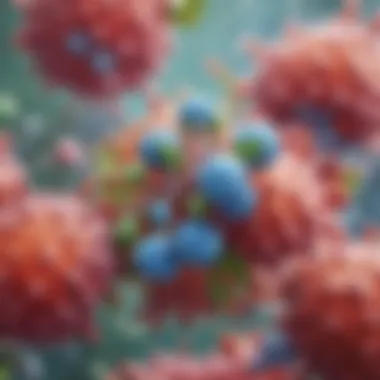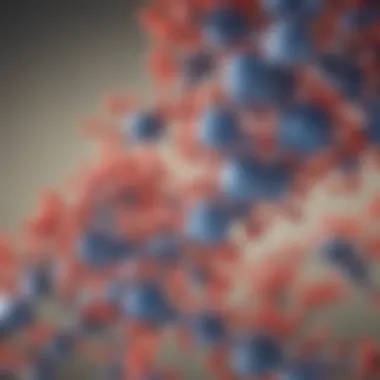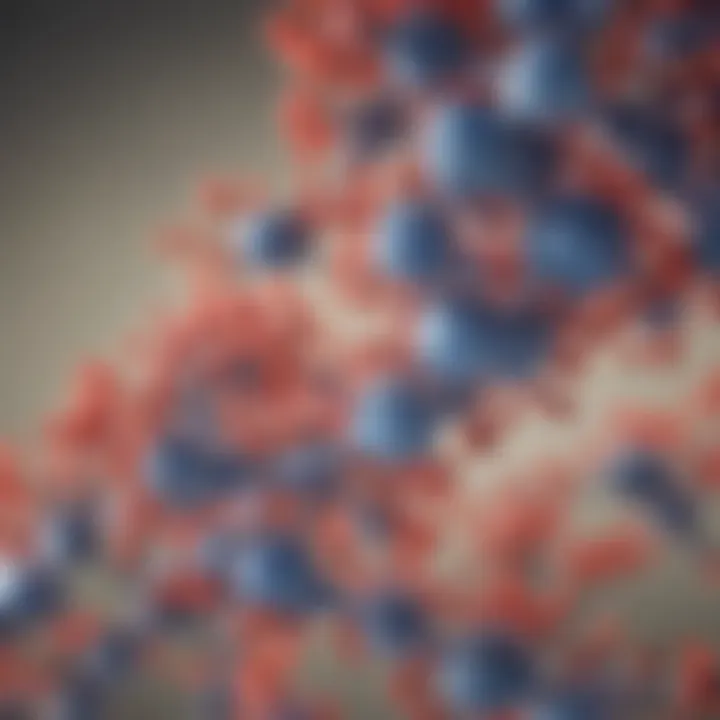Phosphatidyl Inositol 3 Kinase: Mechanisms and Health Implications


Intro
Phosphatidyl inositol 3 kinase (PI3K) plays a multifaceted role in cellular functions, making it a central player in many physiological processes. Beyond its basic function in signaling pathways, PI3K is intricately linked to cellular metabolism, growth, proliferation, and survival. As research advances, its implications in various health conditions have come to the forefront, particularly in understanding the mechanistic roles it plays in cancer, neurodegenerative diseases, and metabolic syndromes.
In the landscape of cellular biology, PI3K operates by phosphorylating phosphatidylinositol-4,5-bisphosphate, producing phosphatidylinositol-3,4,5-trisphosphate. This product activates a cascade of downstream signaling pathways that regulate cellular dynamics. Such processes include insulin signaling, which is crucial for glucose regulation, and other pathways responsible for cell growth and apoptosis. The intricate dance between PI3K and other signaling molecules underscores the kinase's essential nature in both health and disease.
Understanding the workings of PI3K not only sheds light on its biological significance but also highlights its potential as a therapeutic target. Much of the current research focuses on how inhibiting or enhancing PI3K pathways can yield promising results in treating diseases where these signals go awry. If the frame of reference is set rightly, the implications of PI3K stretch far and wide, impacting everything from cancer treatment strategies to addressing neurodegenerative conditions.
Key Findings
Major Results
- Regulatory Mechanisms: PI3K functions as a regulator of various intracellular activities, playing a pivotal role in translating extracellular signals into appropriate cellular responses.
- Disease Implications: Increasing evidence links PI3K to pathological conditions like various cancers, where its overactivation can lead to uncontrolled cell growth. This proves critical in understanding cancer progression and treatment.
- Therapeutic Targeting: Numerous studies suggest that targeting PI3K pathways with specific inhibitors can halt or even reverse disease progression, especially in cancer. These discoveries are moving research towards more nuanced treatment modalities.
Discussion of Findings
The growing body of literature around PI3K illustrates a need to unravel its duality as both a promoter of necessary cellular functions and a contributor to disease states. In cancers, altered PI3K signaling can promote tumorigenesis and metastasis, suggesting that PI3K inhibitors may serve as a frontline therapy. In metabolic disorders, understanding PI3K's role in insulin signaling can point towards new interventions for conditions like type 2 diabetes. The conversation around PI3K's functions continues to evolve, urging deeper studies into its mechanisms and potential as a drug target in future medicine.
Methodology
Research Design
The exploration of PI3K's roles has employed a mixture of in vitro and in vivo methodologies, ranging from cell culture experiments to animal models. This blend provides insights into both fundamental biology and the complexities of living organisms, facilitating a comprehensive understanding of PI3K's functioning in various settings.
Data Collection Methods
Data on PI3K functions are commonly gathered through:
- Biochemical assays: To assess PI3K activity and its effects on downstream signaling molecules.
- Molecular imaging: Allowing for visualization of PI3K activity in live tissues.
- Genomic and proteomic analyses: To uncover how PI3K interacts with other cellular components and pathways.
Finally, as the narrative unfolds around PI3K, it becomes apparent that exploring its vast landscape will reap benefits not only for academic inquiry but also for real-world applications in medicine and therapeutic strategies.
Prelude to Phosphatidyl Inositol Kinase
Understanding phosphatidyl inositol 3 kinase, commonly referred to as PI3K, is pivotal for anyone delving into modern cellular biology. Its relevance stretches far beyond mere academic interest; the pathways and mechanisms associated with PI3K hold significant sway over various physiological processes in the human body. From influencing cell growth to impacting metabolic functions, PI3K's role is broad and complex. This introductory section aims to illuminate the intricacies surrounding PI3K, setting the stage for deeper exploration into its various functions and implications for health and disease.
Overview of PI3K
Phosphatidyl inositol 3 kinase is a lipid kinase that phosphorylates the 3-position hydroxyl group of the inositol ring of phosphatidyl inositol. This seemingly simple action launches a cascade of cellular signals that govern key functions. At its core, PI3K exists in several classes, each contributing to its diverse roles in signaling pathways.
PI3K typically serves as a conduit translating extracellular signals from various receptors, such as growth factors and hormones, into intracellular responses. The versatility of PI3K arises from its ability to interact with several different molecular partners, influencing numerous downstream effectors that are crucial for survival, proliferation, and differentiation of cells.
To grasp the full spectrum of PI3K's functions, it is essential to acknowledge its connection to other signaling pathways, particularly the pathways activated by receptor tyrosine kinases and G-protein coupled receptors. This interconnectedness forms a complex web that regulates cellular homeostasis.
Historical Context
The discovery of PI3K marks a turning point in cellular signaling research. Initial identification dates back to the late 20th century, where researchers began unraveling the pathways controlling cell growth and metabolism. The early 1990s saw the first evidence of a lipid kinase playing a fundamental role in signaling pathways, shifting how biochemists conceptualized the interplay between lipids and proteins in cellular communication.
As the field evolved, so too did our understanding of PI3K's implications in disease states. With links to cancer, diabetes, and even neurodegenerative diseases, PI3K attracted considerable attention in medical research. This has prompted extensive studies aimed at developing therapies that target PI3K-related pathways, potentially opening doors to novel treatment modalities.
Significance in Cellular Signaling
The significance of PI3K cannot be overstated. It acts as a central node within many signaling networks, mediating various essential cellular functions. Here are a few key roles that highlight its importance:
- Cell Growth and Survival: PI3K is crucial for promoting cell survival by activating the AKT signaling pathway, which helps fend off apoptosis.
- Glucose Metabolism: By influencing insulin signaling, PI3K plays a role in glucose uptake in various tissues, a vital aspect of metabolic homeostasis.
- Cell Migration and Invasion: PI3K aids in cytoskeletal reorganization, allowing cells to migrate, which is particularly relevant in wound healing and cancer metastasis.
In summary, the understanding of PI3K serves as the foundation for comprehending more complex biological phenomena. Its mechanisms are not just theoretical but bear direct implications for health and disease, making PI3K a critical focal point in the study of modern biology and medicine.
Structure and Classification of PI3K
Understanding the structure and classification of phosphatidyl inositol 3 kinase (PI3K) is vital for grasping its various functions in cellular mechanisms. The distinct components of PI3K not only dictate its action but also reveal how its manipulation can potentially drive therapeutic strategies. The organization of PI3K into classes illustrates its evolutionary adaptation and functional diversity, which is essential in contexts from cancer therapy to metabolic regulation.
Enzymatic Structure
The enzymatic structure of PI3K can be somewhat multifaceted yet rather intriguing. Primarily, PI3K is comprised of two main units: a catalytic subunit and a regulatory subunit. The catalytic subunit is responsible for the enzymatic activity that converts phosphatidylinositol (PI) into phosphatidylinositol 3-phosphate (PIP3), a crucial signaling molecule.
Moreover, the catalytic aspect has three distinct classes that further develop the complexity of PI3K's roles. Its regulation is intricately tied to these units, with each having the potential to influence signaling pathways significantly. When looking at how PI3K interacts with other proteins or lipids, it becomes apparent that this structure not only governs its action but also determines its specificity, thus making it a point of interest in targeted therapies.
Classification of PI3K Family
The classification of PI3K into multiple classes is based on their structure, function, and role in signaling pathways. Recognizing these distinctions can shed light on their specific contributions to biological processes.
Class PI3K
Class I PI3Ks are perhaps the most well-known for their role in cellular signaling. They are primarily activated by receptor tyrosine kinases (RTKs) and are pivotal in promoting growth and survival signals. One characteristic that stands out for Class I PI3K is its ability to initiate a cascade of downstream signaling by producing PIP3. This class is often seen as the main player in various pathways leading to cell proliferation.
However, these kinase enzymes have their own quirks, too. The adaptive nature of Class I PI3Ks can lead to dysregulation, especially in cancers, where mutations or alterations can result in uncontrolled cellular functions. This makes them an attractive but also a challenging target for therapies.


Class PI3K
In comparison, Class II PI3Ks somehow take the backseat in terms of signaling. They have a more specialized function focused on cellular responses to external stimuli. A well-defined feature of Class II PI3K is its unique involvement in the regulation of vesicular trafficking and membrane dynamics, often influencing processes like endocytosis.
The complexity of Class II PI3Ks can boost therapeutic strategies as targeting these rather understudied kinases can shed light on new pathways that influence metabolic disorders. Yet, their less predictable nature means the research surrounding them must be meticulous, leading some to overlook their potential.
Class PI3K
Finally, Class III PI3K has gained attention due to its high conservation and involvement in autophagy processes. This class emphasizes a distinctive aspect of PI3K function: it doesn't just signal but also regulates cellular turnover through various mechanisms. For instance, its key characteristic is promoting the formation of phagophores and eventual autophagic vesicles.
While it may not be as prominent as Class I, its role in cellular maintenance presents an intriguing area to explore, especially in the context of neurodegenerative diseases. The unique feature of Class III PI3K is its ability to signal in pathways related to stress response, thereby presenting both advantages and challenges in therapeutic targeting.
Activation Mechanisms of PI3K
The activation mechanisms of phosphatidyl inositol 3 kinase (PI3K) are crucial for understanding its role in a variety of cellular processes. This section explores different avenues through which PI3K can be activated, highlighting its significance in regulating pathways that control cell growth, survival, and metabolism.
Receptor Tyrosine Kinases
Receptor tyrosine kinases (RTKs) serve as critical players in the activation of PI3K. These membrane proteins, upon binding with specific ligands, undergo autophosphorylation, which initiates a cascade of intracellular signaling events. One of the most notable examples is the epidermal growth factor receptor (EGFR). When the EGFR is engaged by its ligand, the kinase activity is amplified, leading to the recruitment of PI3K to the plasma membrane. This interaction not only increases the local concentration of PI3K but also provides favorable conditions for its activation.
This activation results in the production of the lipid second messenger phosphatidylinositol-(3,4,5)-trisphosphate (PIP3), which subsequently activates downstream proteins, including Akt, a crucial mediator in cell survival and metabolism. The intricate interplay exemplifies how RTKs can modulate cellular functions through PI3K, affecting processes ranging from cell division to apoptosis.
G-Protein Coupled Receptors
Another significant route for PI3K activation is via G-protein coupled receptors (GPCRs). These receptors, known for their widespread presence in various physiological systems, interact with guanine nucleotide-binding proteins (G-proteins). When a ligand binds to a GPCR, the receptor undergoes a conformational change, activating the associated G-protein. This, in turn, can lead to the activation of phospholipase C or direct activation of PI3K.
In particular, certain GPCRs have been shown to activate the catalytic subunit of PI3K directly. For instance, the interaction between GPCR and its Gα subunit can initiate a signaling cascade that results in the formation of PIP3. This method highlights the versatility of PI3K as a signaling hub, responding to a wide range of extracellular signals, and modifying cellular responses effectively.
Regulatory Subunits of PI3K
The activation of PI3K is not solely reliant on its catalytic subunits, but also heavily influenced by its regulatory subunits. These subunits play a critical role in the recruitment and stabilization of the PI3K complex at the cell membrane, as well as in determining the specificity of PI3K signaling. The p85 regulatory subunit, for example, is well-known for its capacity to bind to phosphorylated RTKs, bringing the catalytic p110 subunit into proximity with its substrate.
The interaction between the regulatory and catalytic subunits of PI3K is essential for its function. The regulatory subunits can also modulate the activity of the catalytic subunit, thereby influencing the intensity and duration of the signaling response. A fine-tuned relationship between the regulatory and catalytic components of PI3K ensures that cellular responses can be appropriately controlled, adapting to varying stimuli and demands.
The complex mechanisms of PI3K activation exemplify its role as a pivotal player in the orchestration of numerous physiological functions, establishing it as a significant target in therapeutic contexts.
In summary, the various mechanisms by which PI3K is activated underscores its significance in cellular signaling pathways that are crucial for maintaining homeostasis, responding to growth signals, and modulating metabolic states. Understanding these activation mechanisms provides valuable insights into the potential therapeutic targeting of PI3K in various diseases.
Cellular Functions of PI3K
Phosphatidylinositol 3-kinase (PI3K) plays a pivotal role in various cellular functions that are fundamental to maintaining overall cellular health and homeostasis. The functions served by PI3K are not merely simplistically biological; they impact numerous aspects of cellular activity including growth, metabolism, and signaling. This section delves deep into the cellular functions of PI3K, exploring its regulation of cell growth, lipid metabolism, and its crucial place in insulin signaling. Understanding these cellular mechanisms is vital for appreciating how disturbances in PI3K pathways can lead to numerous diseases, making this knowledge essential for both researchers and practitioners alike.
Regulation of Cell Growth and Proliferation
One of the most significant roles of PI3K is in regulating cell growth and proliferation. It acts as a key player in the cellular signaling pathways, particularly through the activation of downstream targets like AKT/mTOR pathways. When PI3K is activated, it leads to the production of PIP3, which recruits and activates AKT. This pathway is involved in several processes that facilitate not just cell growth, but also survival and proliferation. In a nutshell, without a properly functioning PI3K pathway, cells may not receive the necessary signals to grow and divide, potentially leading to stunted growth or even cell death.
Moreover, the importance of this pathway is evident in various conditions. For example, cancer cells often exhibit aberrant PI3K signaling, which allows for unchecked growth and survival – a hallmark of tumorigenesis. Furthermore, emerging studies suggest a fine balance in PI3K activity where both too little and too much can have detrimental effects. This balance is so crucial that therapeutic strategies targeting PI3K’s activity are being researched intensely in the context of cancer treatment.
Role in Lipid Metabolism
PI3K also plays a significant part in lipid metabolism, with implications that stretch from energy production to maintaining lipid homeostasis within cells. Here’s where the complexity comes into play; by influencing pathways responsible for fat storage and breakdown, PI3K helps regulate metabolism in a holistic manner. The activation of PI3K can stimulate the synthesis of lipids, which are vital for creating cell membranes and storing energy efficiently.
In conditions like obesity and type 2 diabetes, dysfunctional PI3K signaling can lead to metabolic syndromes characterized by abnormal lipid levels. There’s also evidence suggesting that alterations in lipid metabolism can have far-reaching implications, not just for metabolic health, but also for inflammation and insulin sensitivity.
Impact on Insulin Signaling
Lastly, the impact of PI3K on insulin signaling cannot be overlooked. Insulin is essential for controlling blood sugar levels and facilitating cellular uptake of glucose, and PI3K is a critical component of the insulin signaling pathway. When insulin binds to its receptor, PI3K is activated, initiating a cascade that aids glucose uptake through GLUT4 transporter recruitment on cell membranes. In this context, PI3K essentially functions as a bridge that connects insulin's actions to cellular responses.
The relationship between PI3K and insulin signaling is particularly noteworthy in terms of metabolic disease. In insulin resistance, often seen in type 2 diabetes, PI3K signaling is impaired, leading to insufficient glucose uptake and elevated blood sugar levels. Thus, restoring PI3K function in such cases may present a viable therapeutic approach.
"The orchestration of cellular functions by PI3K cannot be understated, as it serves as a linchpin for various crucial biological processes."
In summary, understanding the cellular functions of PI3K is not just a matter of academic interest; it has profound implications for health and disease. As researchers continue to unravel these intricate pathways, it becomes increasingly clear how vital PI3K is in maintaining cellular equilibrium and response to various stimuli.
PI3K Pathway in Cancer Biology
The phosphatidylinositol 3-kinase (PI3K) pathway holds a pivotal role in cancer biology, serving as a crucial mediator in various tumorigenic processes. This pathway’s dysregulation can lead to uncontrolled cell growth, survival, and metabolism, ultimately influencing cancer progression. Given the significant impact that PI3K has in oncogenesis, it has become an essential target for therapeutic interventions. Understanding the nuances of this pathway is paramount for developing novel cancer treatments and improving patient outcomes.
Mutations and Dysregulation of PI3K
Mutations in the genes encoding PI3K, especially the PIK3CA oncogene, are frequently found in numerous cancers, such as breast, colorectal, and endometrial cancers. These mutations often result in constitutive activation of the PI3K pathway, leading to enhanced cell proliferation and resistance to apoptosis.
Several distinct mutations have been identified, each contributing differently to oncogenesis. For instance, the E545K mutation frequently occurs in the helical domain, promoting aggressive cancer behavior by intensifying PI3K signaling.
Key Points about Mutations:
- Frequency: PIK3CA mutations occur in about 30-40% of breast cancers.
- Impact on Prognosis: Tumors harboring these mutations may respond poorly to traditional therapies.
- Resistance Mechanisms: Mutations may also lead to activation of downstream signaling pathways that render cancers resistant to current treatments.
These insights underline the urgency for targeted therapeutic strategies aimed at countering the specific effects of these mutations.


Targeting PI3K in Cancer Therapy
A focused approach on the PI3K pathway has led to the development of several therapeutic options, ranging from small molecule inhibitors to monoclonal antibodies. Targeting this pathway can help revert cancer cells to a more normal state of regulation and sensitivity to treatment.
Small Molecule Inhibitors
Small molecule inhibitors represent a significant advancement in targeted cancer therapy. These inhibitors, like Idelalisib and Copanlisib, specifically block the activity of PI3K, effectively reducing cell survival and proliferation in tumors with aberrant PI3K signaling.
Key characteristics of these inhibitors include:
- Selectivity: They have been designed to selectively target specific isoforms of the PI3K family, minimizing off-target effects.
- Clinical Utility: Particularly okay in hematological malignancies and certain solid tumors.
The specificity of small molecule inhibitors not only targets cancer cells effectively but also helps in preserving healthy tissues from collateral damage.
Despite their advantages, these inhibitors may present challenges in terms of resistance mechanisms and their side effects, demanding a careful approach in clinical application.
Monoclonal Antibodies
Monoclonal antibodies, such as Trastuzumab, have revolutionized cancer therapy by providing a targeted mechanism to inhibit the PI3K pathway. These antibodies can directly bind to receptors, blocking the signals that drive tumor growth. With their ability to invoke immune responses against cancer cells, they add another layer to PI3K-targeted therapies.
Key characteristics to note:
- Targeted Action: By binding to specific antigens on cancer cells, they enhance immune-mediated destruction of tumors.
- Combination Potential: Monoclonal antibodies often work best when combined with other treatments, enhancing overall therapeutic efficacy.
On the downside, the production of monoclonal antibodies is complex and costly, and the risk of immunogenicity may also limit their effectiveness in some patients.
Combination Therapies
The concept of combination therapies stands out in cancer treatment, merging different modalities to achieve synergistic effects. Combining PI3K inhibitors with other agents—like chemotherapy or immunotherapy—has shown promising results in preclinical studies and clinical trials.
Advantages of this approach include:
- Increased Efficacy: Targeting multiple pathways can help overcome resistance that often limits single-agent therapies.
- Customized Treatment Plans: They lend themselves well to personalized medicine, tailoring combinations to individual patient profiles.
However, the intricacies of balancing these combinations also pose challenges; side effects can be heightened, and optimal dosing schedules can become complicated.
In summary, the PI3K pathway not only plays a fundamental role in cancer biology through mutations and signal dysregulation but also shines as the focal point for innovative therapeutic strategies. The spectrum of treatment options, from small molecule inhibitors to monoclonal antibodies and combination therapies, underscores the pathway's prominence in ongoing cancer research and clinical applications.
PI3K in Metabolic Disorders
Phosphatidyl inositol 3 kinase (PI3K) plays a crucial role in metabolic disorders, particularly in conditions such as obesity, diabetes, and cardiovascular diseases. Understanding the functions of PI3K in these areas is essential, considering the increasing prevalence of metabolic diseases worldwide and their significant impact on public health.
Role in Obesity and Diabetes
The interaction between PI3K and insulin signaling pathways highlights the key role this enzyme plays in the regulation of glucose uptake and metabolism. In individuals with obesity, the signaling pathways can become dysregulated, leading to insulin resistance. This resistance hampers the effective use of insulin, elevating blood sugar levels and contributing to the development of type 2 diabetes.
Here are some specific insights into how PI3K functions in the context of obesity and diabetes:
- Insulin signaling facilitation: Under normal conditions, insulin binds to its receptor, which activates PI3K. This activation subsequently triggers a signaling cascade that promotes glucose transporter type 4 (GLUT4) translocation to the cell surface, allowing glucose uptake.
- Dysregulation in obesity: In obesity, excess fatty acids and inflammatory cytokines interfere with insulin signaling. This leads to altered PI3K activity, causing diminished insulin sensitivity and impaired glucose metabolism, a pathway often observed leading to diabetes.
- Therapeutic targeting: Approaches that aim to enhance PI3K activity or mimic its function are being explored as potential strategies. This includes the use of small molecules designed to selectively target and activate the PI3K pathway, thereby restoring insulin sensitivity.
Overall, PI3K's role in maintaining metabolic homeostasis emphasizes its significance in obesity and diabetes, making it a promising target for therapeutic intervention.
Connection to Cardiovascular Disease
The implications of PI3K in cardiovascular disease are pronounced. The pathway modulates various factors that contribute to vascular health, impacting conditions such as atherosclerosis and hypertension.
Several points worth noting include:
- Endothelial function: PI3K is integral in mediating the release of nitric oxide from endothelial cells, which is vital for maintaining vascular tone and preventing atherosclerosis. When PI3K signaling becomes impaired, endothelial dysfunction can occur, possibly leading to increased cardiovascular risk.
- Inflammation and plaque formation: In the context of atherosclerosis, activated immune responses can alter PI3K pathways, contributing to inflammatory cell recruitment in arterial walls and promoting plaque formation. This interaction highlights a complex relationship between metabolism, PI3K signaling, and cardiovascular diseases.
- Targeted therapies: Investigating the role of PI3K in cardiovascular diseases opens new avenues for therapeutic options. Potential treatments may target PI3K pathways to improve endothelial functions and reduce inflammation, thereby mitigating cardiovascular risks associated with metabolic disorders.
In summary, the intricate connections between PI3K, metabolic disorders like obesity and diabetes, and cardiovascular disease underscore the enzyme's importance in maintaining health. This emphasis on PI3K not only highlights the challenges but also the therapeutic opportunities that lie ahead, paving the way for future research and clinical advancements.
Implications of PI3K in Neurodegenerative Diseases
Understanding the implications of phosphatidyl inositol 3 kinase (PI3K) in neurodegenerative diseases is absolutely vital for unraveling the complexities of conditions like Alzheimer's and Parkinson's disease. The involvement of PI3K in cellular signaling pathways highlights its potential as a therapeutic target, making it an area of growing interest for researchers and healthcare professionals alike. By exploring how PI3K contributes to neuronal health and disease, we gain insight into possible interventions that could alter the course of these debilitating disorders.
Neurodegenerative diseases often lead to the gradual loss of neuronal function and can severely impact memory, cognition, and motor skills. One key element to consider in this context is that PI3K signaling has been shown to be involved in mitochondrial function, cell survival, and inflammation—all critical players in the development of these diseases. Therefore, understanding PI3K's roles could provide several benefits:
- Targeting Pathways: Identifying specific pathways that PI3K affects can lead to targeted therapies that might slow disease progression.
- Biomarker Potential: Understanding the expression levels or mutations of PI3K components can lead to the discovery of biomarkers for early diagnosis.
- Intervention Possibilities: Knowledge of PI3K’s functional disruptions can inspire novel treatment strategies and pharmacological interventions.
Nonetheless, the implications of targeting PI3K are not without challenges. The dual role of PI3K in promoting cell survival while also contributing to disease pathology presents a dichotomy that researchers must navigate carefully. This delicate balance underscores the need for a nuanced understanding of PI3K activity in the nervous system.
PI3K and Alzheimer's Disease
Alzheimer's disease (AD) is characterized by the accumulation of amyloid plaques and tau tangles, leading to synaptic dysfunction and neuronal death. Recent studies indicate that PI3K signaling pathways play a pivotal role in these processes. For one, PI3K contributes to the regulation of amyloid precursor protein (APP), and alterations in this regulation can influence amyloid-beta production, a hallmark of AD pathology.
Moreover, the neuroprotective effects of PI3K are particularly relevant in the context of AD. Activation of PI3K signaling promotes cell survival by inhibiting apoptosis and fostering neuronal resilience to stressors. In this regard, it’s essential to understand that a reduction in PI3K activity has been correlated with increased sensitivity to neurotoxic agents and accelerated neurodegeneration associated with Alzheimer’s.


Potential therapeutic strategies that target PI3K in AD could include:
- PI3K Activators: These compounds may enhance the pathway’s protective effects against neuronal loss.
- Combination Therapies: Pairing PI3K pathway modulators with existing AD treatments or novel agents could yield synergistic benefits.
In essence, thoroughly delving into the connections between PI3K and Alzheimer's disease can unlock new avenues for intervention that could significantly alter the landscape of AD management.
PI3K's Role in Parkinson's Disease
Parkinson's disease (PD), another neurodegenerative condition, presents a different yet equally complex relationship with PI3K. The primary hallmark of PD is the degeneration of dopaminergic neurons in the substantia nigra, leading to motor dysfunction and a range of non-motor symptoms. Emerging research suggests that PI3K is involved in maintaining dopaminergic neuron health, possibly through its influence on autophagy and mitochondrial function, both of which are crucial for neuronal survival.
Dysregulation of the PI3K pathway has been linked to the pathogenesis of Parkinson's, with some studies indicating that reduced PI3K activity results in increased α-synuclein accumulation. This protein is notorious for forming toxic aggregates that contribute to neuronal toxicity in PD. Understanding how PI3K modulates these processes may lead to new strategies aimed at preserving neuronal health and preventing disease progression.
Key approaches to targeting PI3K in PD include:
- Mitophagy Enhancers: Supporting mitochondrial quality control through PI3K activation may help protect neurons from degeneration.
- Neuroprotective Agents: Exploring compounds that might enhance PI3K activity as a preventative or therapeutic measure could prove beneficial.
Therapeutic Targeting of PI3K
Therapeutic targeting of phosphatidyl inositol 3 kinase (PI3K) has garnered significant attention due to its intricate role in various diseases, especially cancers and metabolic disorders. By honing in on PI3K, researchers aim to develop strategies that can modify its activity, paving the way for innovative treatments. Understanding the implications of this targeting is crucial as it offers potential benefits while also presenting unique challenges.
When focusing on this topic, several considerations arise. The PI3K pathway is deeply entwined with cellular growth, survival, and metabolism. This means that any intervention can dramatically influence cellular behaviors, with responses varying across different cell types. Thus, the targeting of PI3K is not solely about inhibiting its activity. Rather, it's about achieving a nuanced understanding of how to balance its roles in health and disease.
Current Therapeutics in Clinical Trials
A wealth of therapeutics aimed at PI3K are currently being investigated in clinical trials. These compounds fall under a couple of key categories:
- Small Molecule Inhibitors: These molecules aim to precisely inhibit the activity of specific PI3K isoforms. For instance, drugs like Idelalisib have shown promise in treating hematological malignancies, highlighting the potential of PI3K inhibitors in certain cancer types.
- Monoclonal Antibodies: These biologics are designed to target the receptors and pathways linked with PI3K activation. They are often used in combination with existing therapies, enhancing the overall efficacy while potentially reducing side effects.
Moreover, combination therapies are rapidly becoming a focal point in this area. Synergistic approaches—blending PI3K inhibitors with chemotherapy or radiation—could enhance treatment effectiveness, yielding better outcomes for patients battling resistant forms of cancer.
"As researchers continue to expand the landscape of PI3K-targeted therapies, the horizon seems brighter for addressing conditions once deemed difficult to treat."
Challenges in Targeting PI3K
Despite the advances made in therapeutic strategies, several challenges are entailed in targeting PI3K therapeutic approaches:
- Heterogeneity of Tumors: Tumors often exhibit a vast array of genetic and phenotypic variations. This heterogeneity means that a drug effective in one tumor type may be ineffective in another, complicating treatment plans.
- Feedback Mechanisms: The PI3K pathway is part of a larger network of cellular signaling pathways. Inhibition of PI3K can trigger compensatory mechanisms, leading to pathway reactivation and reduced therapeutic effectiveness.
- Side Effects: While targeting PI3K offers therapeutic advantages, it can also lead to adverse effects. As PI3K plays essential roles in normal cellular functions, its inhibition may impact healthy tissues, leading to complications such as immune suppression or metabolic issues.
Addressing these challenges demands ongoing research and collaboration among scientists, physicians, and industry partners. Tailoring therapeutic strategies based on individual patient profiles and tumor characteristics may offer a solution, leading to more effective and safer use of PI3K-targeted therapies.
Future Directions in PI3K Research
The landscape of PI3K research continues to evolve, revealing novel insights into its multifaceted roles in health and disease. As researchers delve deeper, it becomes clear that understanding PI3K not only illuminates fundamental cellular processes, but also opens new frontiers for therapeutic interventions. The future of PI3K research is paramount in fleshing out its potential in clinical settings, particularly concerning cancer, metabolic disorders, and neurological diseases.
The pursuit of new therapeutic strategies based on PI3K modulation can yield significant benefits. It presents opportunities to tailor treatments to individual patient profiles, thereby enhancing efficacy and minimizing adverse effects.
Emerging PI3K Inhibitors
With the growing body of evidence linking PI3K to various malignancies, the development of PI3K inhibitors has garnered considerable attention. Several specific inhibitors are advancing through clinical trials, showcasing promising results in obstructing tumor growth and enhancing treatment outcomes.
- Idelalisib: Approved for chronic lymphocytic leukemia, Idelalisib showcases how targeting the PI3K pathway changes the treatment game.
- Copanlisib: With its unique dual action on both PI3K and immune modulation, Copanlisib holds potential for various lymphoid malignancies.
- Alpelisib: Specifically targeting PI3K alpha, Alpelisib represents a precision medicine approach for hormone receptor-positive breast cancer.
The focus on developing emerging inhibitors brings along many considerations. Backbone support from combinatorial therapies often proves essential to maximize the effectiveness of these inhibitors.
Potential for Personalized Medicine
As research illuminates the PI3K pathway's diverse roles across different cellular contexts, the potential for personalized medicine becomes increasingly apparent. Tailoring treatments based on individual genetic and epigenetic profiles can lead to more fruitful outcomes.
"Personalized medicine is the golden ticket we’ve been looking for in oncology, especially with PI3K, which can be a double-edged sword depending on the context."
By employing genomic and proteomic technologies, healthcare providers can identify which patients would benefit the most from specific PI3K inhibitors, thereby redirecting therapeutic resources to those with the highest potential for positive outcomes.
The intersection of personalized medicine and PI3K research is becoming a vibrant field of study, paving the way for advancements in targeted therapies that could very well disrupt the cycle of traditional one-size-fits-all treatment approaches.
In summary, the future directions in PI3K research promise both to unravel the intricacies of cellular signaling pathways and to steer innovative therapeutic strategies, aligning with the increasing demand for tailored healthcare solutions.
Finale
In the exploration of phosphatidyl inositol 3 kinase (PI3K), it’s clear that this enzyme does not merely serve as another cog in the wheel of cellular mechanics but instead plays a pivotal role in regulating numerous physiological functions. The significance of understanding PI3K goes well beyond academic curiosity; it has far-reaching implications in health and disease. For researchers and clinicians alike, the knowledge gained from this body of work can pave the way for innovative therapeutic strategies targeting a variety of maladies.
Summary of Key Insights
The intricate mechanisms by which PI3K operates are a reflection of its importance in cellular signaling. Key insights drawn from the analysis include:
- Diverse Functions: PI3K is vital in multiple cellular processes such as growth, metabolism, and insulin signaling. This versatility is essential for maintaining cellular homeostasis.
- Dysregulation and Disease: Abnormal PI3K signaling is at the heart of many cancers, highlighting the need for targeted therapies that focus on its pathways.
- Therapeutic Targeting: The ongoing development of PI3K inhibitors demonstrates the therapeutic potential of manipulating this pathway, making it a hot topic in cancer biology and other disorders.
Understanding these insights offers a clearer pathway for future research, while also emphasizing the need for careful consideration of the nuances involved in PI3K signaling. The relationship between PI3K and various diseases suggests that targeting this molecule could lead to meaningful improvements in patient outcomes.
Significance in Future Therapeutics
Looking ahead, the importance of PI3K as a therapeutic target cannot be overstated. The insights derived from current research underscore the potential for tailored treatments that can modulate its activity effectively. Considerations for future therapeutics include:
- Personalized Medicine: Understanding individual variations in PI3K pathways may allow for more personalized treatment plans for patients, particularly in oncology.
- Novel Inhibitors: The ongoing search for new PI3K inhibitors could lead to a breakthrough in managing diseases characterized by PI3K dysregulation.
- Combination Strategies: Future treatments may involve combining PI3K inhibitors with other therapies to enhance efficacy and mitigate resistance mechanisms.
In summary, the exploration of PI3K’s mechanisms, functions, and implications in health has opened doors to new horizons in biomedical research and clinical practice. As research progresses, the hope is to harness this knowledge to develop smarter, more effective therapeutic strategies.



